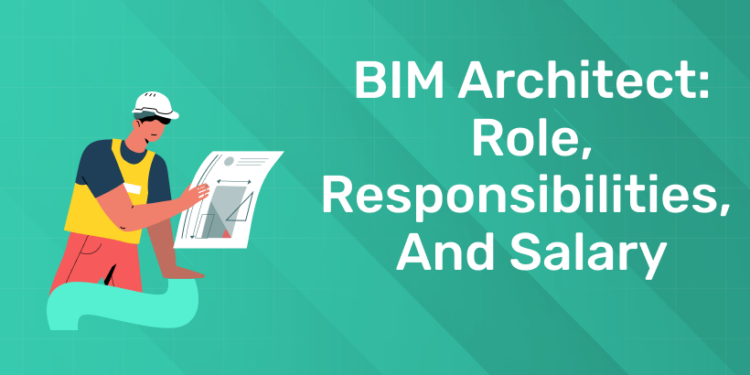Table of Contents
In today’s fast-evolving construction and design industry, Building Information Modeling (BIM) has revolutionized the way buildings are planned, designed, and managed. At the forefront of this transformation is the BIM Architect—a professional who combines architectural expertise with advanced digital tools to streamline project workflows, improve collaboration, and enhance project outcomes. This blog explores the critical role of a BIM Architect, their key responsibilities in modern construction projects, and the skills that set them apart.
Role and Responsibilities
A BIM architect plays a crucial role in integrating digital design and construction processes to enhance project delivery. The responsibilities blend traditional architectural tasks with advanced BIM workflows to ensure effective coordination, visualization, and execution of projects. Below are the primary roles and responsibilities of a BIM Architect:
1. BIM Implementation and Management:
- Develop and manage BIM execution plans (BEP) for projects.
- Define BIM standards, protocols, and workflows based on industry best practices.
- Ensure the integration of BIM technologies into the design process and throughout the project lifecycle.
2. Model Development and Coordination:
- Create and manage 3D models using software like Revit, ArchiCAD, or similar tools.
- Collaborate with other disciplines (MEP, structural engineers, etc.) to ensure clash-free coordination of models.
- Manage and maintain accuracy, consistency, and quality in models throughout the project.
3. Design and Visualization:
- Use BIM tools for design iteration, analysis, and visualization of architectural concepts.
- Support design teams with high-quality presentations, 3D renderings, and virtual walkthroughs.
- Analyze building performance using BIM tools to optimize energy efficiency and sustainability.
4. Collaboration and Coordination:
- Facilitate collaboration between stakeholders (architects, engineers, contractors, and clients) using BIM-based workflows.
- Coordinate multidisciplinary models, identify clashes, and resolve conflicts using clash detection tools like Navisworks.
- Communicate design intent effectively through BIM data to all team members.
Get Career Oriented BIM Certification Course with Expert Mentors! Get Free Demo Here!
5. Project Documentation and Data Management:
- Generate detailed construction documents, including plans, sections, and elevations, directly from BIM models.
- Ensure the accuracy of data integrated within the BIM models (e.g., schedules, material lists, and specifications).
- Manage revisions and updates to the model throughout project phases.
6. Training and Support:
- Train team members on BIM software and workflows (e.g., Revit, Navisworks, Dynamo).
- Provide ongoing technical support to ensure team members can utilize BIM tools effectively.
- Stay updated with new BIM software, tools, and industry trends.
7. Quality Control and Compliance:
- Conduct quality checks to ensure the integrity and compliance of BIM models with project requirements.
- Adhere to international BIM standards (e.g., ISO 19650) and guidelines during the model development process.
8. Project Lifecycle Support:
- Support design, construction, and facility management phases through BIM-based processes.
- Assist in post-construction handovers by providing as-built BIM models for operations and maintenance (O&M).
9. Performance Analysis and Optimization:
- Perform simulations, such as energy analysis, lighting, and spatial analysis, to enhance building performance.
- Optimize design efficiency through parametric modeling tools like Dynamo or Grasshopper.
10. Collaboration with External Stakeholders:
- Act as a liaison between architects, contractors, and clients to ensure BIM goals are achieved.
- Participate in project meetings, reviews, and workshops to facilitate coordination.
A BIM Architect ensures smooth workflows, reduced project errors, and enhanced collaboration, contributing to overall project success and lifecycle efficiency.
Skills and Qualifications
The key skills required by a BIM architect are:
- Proficiency in BIM software (Revit, ArchiCAD, Navisworks, Dynamo, etc.).
- Strong understanding of architecture, construction methods, and building systems.
- Knowledge of BIM standards and protocols (e.g., ISO 19650, PAS 1192).
- Experience with clash detection, data analysis, and model auditing.
- Communication, teamwork, and problem-solving skills.
Master BIM and Elevate Your Career – Enroll Today!
Stay ahead in the construction and design industry with our comprehensive BIM Course! Learn Building Information Modeling (BIM) from experts, gain hands-on experience with top software, and boost your career prospects. Join now and become a certified BIM professional!
Know MoreSalary Expectation
The salary of a BIM Architect can vary based on several factors, such as experience level, location, company size, project complexity, skills, certification and industry demand. Here’s a general breakdown:
Global Salary Ranges (Annual)
1. United States:
Entry Level (0–3 years): $60,000–$80,000
Mid-Level (3–7 years): $80,000–$100,000
Senior Level (7+ years): $100,000–$130,000+
2. United Kingdom:
Entry Level: £30,000–£40,000
Mid-Level: £40,000–£55,000
Senior Level: £55,000–£70,000+
3. Middle East (e.g., UAE, Saudi Arabia):
Entry Level: $30,000–$50,000
Mid-Level: $50,000–$70,000
Senior Level: $70,000–$90,000+ (tax-free income in many cases).
4. India:
Entry Level: ₹4–6 LPA
Mid-Level: ₹6–12 LPA
Senior Level: ₹12–20+ LPA
5. Australia:
Entry Level: AUD 70,000–90,000
Mid-Level: AUD 90,000–110,000
Senior Level: AUD 110,000–130,000+
6. Europe (e.g., Germany, Netherlands):
Entry Level: €35,000–€45,000
Mid-Level: €45,000–€60,000
Senior Level: €60,000–€75,000+
Conclusion
The role of a BIM Architect is pivotal in shaping the future of the architecture, engineering, and construction (AEC) industry. Their responsibilities go beyond traditional design, encompassing model coordination, visualization, and data-driven decision-making, which are essential for modern construction projects.
As the demand for BIM continues to grow globally, skilled BIM professionals are increasingly sought after, with competitive salaries reflecting their importance in the industry. For those aspiring to build a career in BIM, mastering the necessary tools, staying updated with industry standards, and developing strong coordination skills can open the door to exciting opportunities. Join the BIM course on Entri and enhance your career opportunities.
Get Career Oriented BIM Certification Course with Expert Mentors! Get Free Demo Here!
|
Engineering Upskilling Courses
|
| MEP Course |
| BIM Course |
| Quantity Surveyor Course |
| Structural Design Course |
| MEP QS Course |
Master BIM and Elevate Your Career – Enroll Today!
Stay ahead in the construction and design industry with our comprehensive BIM Course! Learn Building Information Modeling (BIM) from experts, gain hands-on experience with top software, and boost your career prospects. Join now and become a certified BIM professional!
Know MoreFrequently Asked Questions
What skills are required to become a BIM Architect?
Essential skills include proficiency in BIM software like Revit, ArchiCAD, and Navisworks, knowledge of BIM standards, strong problem-solving abilities, collaboration, and experience with tools for automation like Dynamo or Grasshopper.
What is the average salary of a BIM Architect?
Salaries vary by region and experience level. In the US, BIM Architects earn between $60,000–$130,000 annually, while in India, it ranges from ₹4–20 LPA. Factors like certifications, skills, and company size can influence pay.
Is BIM a good career choice for architects?
Yes, BIM is an excellent career choice for architects as it is in high demand globally. With increasing adoption of BIM in the AEC industry, professionals skilled in BIM enjoy competitive salaries, career growth, and global opportunities.












